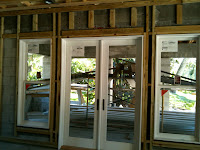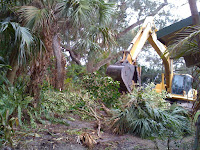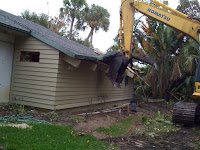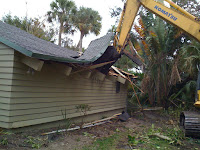There are many reasons to build an energy efficient house but the most persuasive is the realization that the electric grid on which we depend is itself dependent on forces outside its control. Several independent minded homeowners have installed photovoltaic systems so that solar energy can run some or all of their electric appliances. From time to time, one of these homes will be featured here.
Willet Family: a family home of over 4,000 sq.feet with a 18ft x 50ft. heated pool.
year built: 2001
Power Source: 24 solar panels plus panels to heat pool plus a battery bank to back it up as well as a 20 kw LP gas generator.
---Solar system runs indoor lights, microwave oven, refrigerator, washer, outlets, ceiling fans. Pool pump and heat is solar. Also, 120 gallon hot water tank is solar
---FPL's power grid runs other major systems
---Battery back up supplies the indoor lights, microwave over, refrigerator, washer, outlets, and ceiling fans as needed. The batteries are of the sealed variety to reduce maintenance. They require a ventilated space.
Building envelope: Walls are Insulated concrete block (ICF) reinforced with rebar horizontally and vertically every four feet. Insulation rating - R-30. Metal lathe on outside/ stucco/ elastic merit paint (usually used on commercial buildings, but is great at keeping water out.)
--Roof has waterproof membrane/ vinyl soffits with extra caulking and screws to hold them in place. Metal roof trusses (rather than wood)
Floor of attic is 1 inch blueboard/ 1/2 inch plywood/ 1/2 inch sheetrock. This allows workmen to walk in the attic.
--Windows: hurricane windows plus shutters. However, low-e glass was not available in a hurricane window at the time house was built.
--Soundproofing: 5/8 inch sheetrock and fiberglass between walls.
Insulation: closed cell spray foam/ attic insulation R-40
Water: all main lines are 1 inch pipes
--has city water and well water backup
--filters city water to remove chlorine, etc. Also, softens city water.
--All water pipes - hot and cold - are insulated.
--recirculate hot water so that it will be available throughout system.
--perimeter of house has trench filled with pebbles and pipe to drain water away from the foundation
Air conditioning system: Lennox units with 2 stage compressor
--variable speed a/c
--humidistat
--piped to drain water out of building
--media filter with ultraviolet light to prevent mold and dust build up in ducts and on coils
--ceiling fans everywhere
Options: whole house surge protector
--central vacuum
--prewired sound system
--wired for computers and cable tv
--switches on all appliances to cut energy drain
Regrets: putting in a skylight and a solar tube as they are too expensive and created a break in the roof.













+and+dry+brick(right).jpg)































